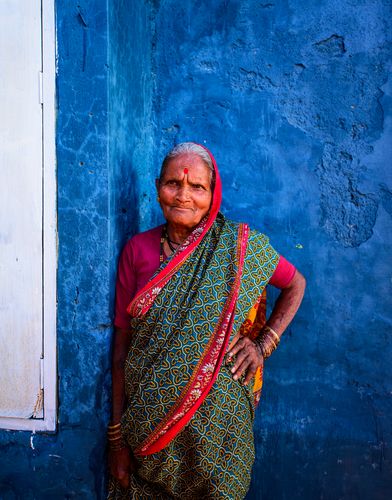 An old woman strikes a pose.
An old woman strikes a pose.
A mention of Mumbai slums usually brings to mind dark, dingy houses with walls crying for a fresh coat of paint. But, the haphazard houses in Asalpha village on the slopes of Ghatkopar hill are bright spots in that gloomy imagery. In December, 15 artists and 750 volunteers, under an initiative called ‘Chal Rang De’, painted 175 walls of the village in vibrant hues of red, pink and yellow in five days. The initiative aims at altering the perspective the world has of urban slums by giving them a colourful makeover.
Dedeepya Reddy, cofounder of FruitBowl Digital, an online marketing firm, is the mind behind this makeover. A bit of colour, she said, can change people’s lives. “If a little colour makes me happy,” she said, “how about filling people’s lives with colours?” So, FruitBowl Digital collaborated with Mumbai Metro One, Snowcem Paints and Co.Lab.Oratory Asia that offers premium co-working space, to start the ‘Chal Rang De’ movement.
“‘Chal Rang De’ started out as our way to change people’s perception of the city slums while also spreading happiness through art and colour,” said Reddy. “Mumbai, as a whole, has so many tales to tell in so many different ways that we just wanted to provide a platform for the local talent to tell theirs, while also giving the community the attention and identity it so rightfully deserved.”
The first phase of the movement, held between December 2 and 4, saw great participation, with more than 1,000 registering to paint the walls of Asalpha village. Of these, 400 people were invited and were provided with paints and brushes.
However, getting permission to enter and paint the houses was easier said than done. The slum-dwellers, said Reddy, were initially sceptical. “Why would you want to paint our house?” was a question often hurled at Reddy. Eventually, after a little convincing and running around to get permission, Reddy’s team managed to paint 120 walls in the village within three days. The effort, in the end, left its residents and spectators amazed.
Following the successful start, the second phase of ‘Chal Rang De’ was held on December 16 and 17. This time, however, 15 artists joined the volunteers, using the walls of the slum as a canvas to portray the lives of its people and the magic that is Mumbai, and turned Asalpha village into an outdoor art gallery.
The movement was inspired by Taiwan’s Rainbow Village, which was earlier a settlement for veteran soldiers. The village got a splash of colour, thanks to a former Kuomintang soldier—Huang Yung-fu—who initially created art on the village walls out of boredom. Later, however, his art helped the rundown houses from demolition, and soon the village became a tourist destination. Another inspiration for the initiative came from Positano, a cliffside village in Italy.
Meanwhile in Mumbai, the Asalpha village is only the beginning; ‘Chal Rang De’ hopes to paint the city, home to 6.5 million slum-dwellers, in vivid colours in the months to come.






